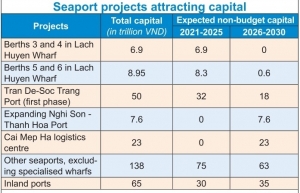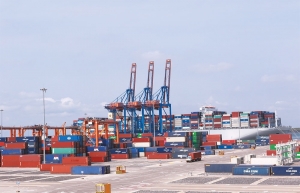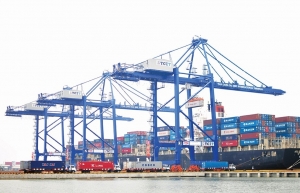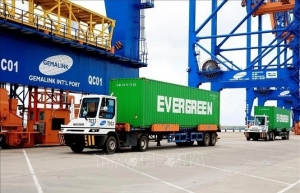Seaports booming, but skilled workers still in short supply
Vietnam’s 286 ports have grown substantially in recent years, reaching a combined length of 96 kilometres (more than 4.5 times that of 2000), while total goods throughput reaching 763 million tonnes in 2023 (about nine times more than that of 2000). In 2021, the national master plan for the development of Vietnam’s seaport system for 2021-2030, with a vision to 2050, was issued.
 |
| Bui Thi Ninh, director, Bureau for Employers’ Activities and Women Entrepreneurs Vietnam Chamber of Commerce and Industry in Ho Chi Minh City |
Under it, Vietnam’s seaport system is divided into five groups with 36 seaports, consisting of two special-class seaports, 15 class-I seaports, six class-II seaports, and 13 class-III seaports.
To keep up with this rapid development and meet its potential, Vietnam’s seaports and logistics industries need a large influx of human capital. Currently, seaport businesses struggle to recruit skilled workers with expertise in seaports and logistics.
Compounding the overall shortage, workers generally lack advanced training, with only around 10 per cent having received job-specific education, and usually require up to two years of on-the-job training after employment. Industry surveys indicate that seaport enterprises typically have around 300-1,000 workers.
With between 960 and 1,050 wharves expected by 2030, demand for specialised human resources will surge, as well as complementary resources needed in the logistics supply chain and post-ports logistics. Despite these enormous and booming needs, Vietnam’s capacity to train and provide for such needs remains limited.
With the support of the Australian government, through Aus4Skills, the Logistics Industry Reference Council (LIRC) recently released the Skills Forecast for Vietnam’s Port Industry 2024-2028. The LIRC, established in 2017, is a pilot sector skills model which links state management agencies, vocational education and training (VET) schools, and businesses operating in logistics, to strengthen cooperation to build skilled workers to meet the requirements of Vietnam’s logistics industry.
The LIRC report provides forecasts on the knowledge, skills, and attitudes towards job positions associated with development trends in the seaport industry. It aims to help the government of Vietnam, seaport and logistics businesses, as well as training institutions to understand trends and future needs of the labour market, and serve as the basis for decision-making on workforce, training, and investment in these key industries.
The Vietnam Maritime Administration has recognised the report as an important mechanism for helping port industry training facilities build and adapt training to market needs, as well as serving as a reference to allow seaport businesses to build their human resource development strategies.
According to the Forecast Report, Vietnam’s seaport and inland container depot enterprises constantly experience severe personnel shortages for certain positions. This includes vehicle and equipment operators, technical workers and dockworkers, technical workers for facility repair and maintenance, and planning workers and coordinators for ships, wharves, yards, warehouses, and vehicles.
Industry surveys indicate that the level of essential job knowledge and skills for the average seaport worker in Vietnam is relatively inadequate, especially for IT and digital technology, language proficiency, and knowledge of environmental protection and emergency response.
At the same time, surveys also emphasise that over the next five years, port workers will need to have a high level of understanding and skill in work health and safety, regulations and policies (including corporate information security), integrity, diligence, and accountability.
Against the robust backdrop of globalisation, Industry 4.0, and digitalisation, the quality, expertise, and skills of human resources in the logistics industry will need to adapt to meet emerging demands in the ever-changing employment landscape. This is especially so for the port industry, which by its nature is intrinsically integrated with the rest of the world and means domestic and global workforce demands are closely related as well.
To solve current human resource shortages and improve the quality of human resources, cooperation across all stakeholders is required, including state management agencies, VET schools, and seaport enterprises.
There needs to be an effective cooperation mechanism between these parties to create a comprehensive human resource development strategy that accounts for the direction and development trends of the industry.
This will mobilise businesses to proactively participate in capacity development of labour for the industry, through timely provision of information and industry requirements on current and future skills/competencies.
 | Seaport ventures to rake in new funds The Ministry of Transport this month submitted a report requesting approval to implement the master plan for Vietnam’s seaport system for the 2021-2030 period. |
 | Seaports missing out on fee windfalls Vietnamese shipping organisations’ proposal to raise charges for container loading and unloading services at seaports, if becomes true, will not affect exporters and importers. |
 | 17 billion USD needed to build railway connecting to seaports As much as 17 billion USD is needed to build two railway routes connecting to seaports, namely Lao Cai-Hanoi-Hai Phong and Bien Hoa-Vung Tau, according to the Ministry of Transport (MoT). |
 | Seaport investment creates new promise The seaport industry’s evolution in Vietnam continues to be driven by the government’s development strategy towards 2030 and beyond. |
 | Vietnamese seaports to handle 1.2-1.4 billion tonnes of cargo by 2030 Vietnam's seaport cargo throughput is set to reach 1.2-1.4 billion tonnes by 2030, with container cargo expected to range from 46.3 to 54.34 million TEUs, according to a detailed plan for the development of seaport groups, wharfs, jetties, buoy berths, and water areas in 2021-2030, with a vision to 2050. |
What the stars mean:
★ Poor ★ ★ Promising ★★★ Good ★★★★ Very good ★★★★★ Exceptional
Related Contents
Latest News
More News
- Main drivers for Vietnam’s digital economy future (December 03, 2025 | 11:35)
- Pivotal stage of growth paves way for rise in M&As (December 03, 2025 | 10:00)
- Positive projections for M&A interest from Thailand (December 03, 2025 | 09:40)
- Manifesting the first line of defence in cybersecurity (December 03, 2025 | 09:00)
- The transformational role AI can play in accounting arena (December 03, 2025 | 08:00)
- Unlocking 5G-AI potential in Singapore (December 03, 2025 | 08:00)
- Data-driven strategies vital for a fast-evolving nation (December 02, 2025 | 09:41)
- Policy to practice: how Vietnam can lead the region (November 26, 2025 | 16:03)
- Mobilising private capital at scale vital for climate battle (November 26, 2025 | 15:36)
- VILAF and Yoon & Yang launch Vietnam - Korea Practice Unit (November 26, 2025 | 15:16)

 Tag:
Tag:




















 Mobile Version
Mobile Version